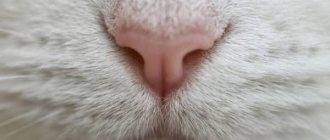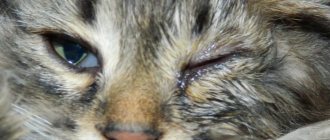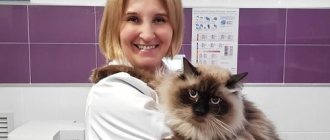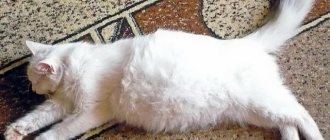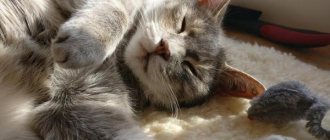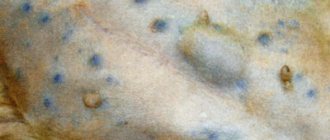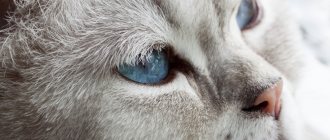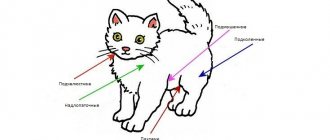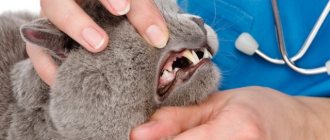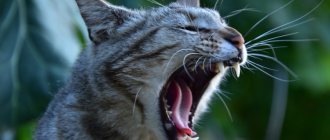A change in the color of visible mucous membranes is called anemia in veterinary and human medicine. During the development of the pathological process, the number of red blood cells and iron-containing protein decreases in the bloodstream. Anemia is not an independent disease - it is a kind of signal from the body, indicating the development of disorders in the functioning of certain systems.
Iron-containing protein, hemoglobin, is vital for the body, since thanks to it, oxygen is delivered to the tissue structures of the body. A cat suffering from advanced forms of anemia exhibits pronounced signs of hypoxia.
Normal color of mucous membranes in cats
Red blood cells are erythrocytes produced in the body in the bone marrow area. Subsequently, they penetrate into the systemic bloodstream, where they remain for about 120 days. As soon as red blood cells begin to age and become damaged, they are removed, and new blood cells begin to be produced from their remains. During the life of an animal's body, the number of red blood cells decreases due to a sharp loss of blood or as a result of their reduced production by the bone marrow.
A characteristic manifestation of anemia in animals is a change in the shade of visible mucous membranes. Under normal conditions, cats' gums are pink. With the development of anemia, the mucous membranes acquire a pale pink and sometimes white tint. The animal becomes lethargic and less resilient. If the cat owner has noted the whitishness of visible mucous membranes, lips and increased fatigue in the pet, it is necessary to contact a veterinary clinic for help and advice.
Hypopigmentation (lightening)
There are several genetic diseases in cats that result in a lack of pigment in the hair and skin. They are quite rare and cannot be treated:
- Persian cats have a bluish-smoky color with yellow eyes and have Chediak-Higashi syndrome. This disease causes not only discoloration of the coat, but also partial albinism of the eyes, photophobia and cataracts.
- Siamese cats (more often females) have vitiligo. In young animals, progressive patchy depigmentation of the nose, lips, eyelids, paw pads, and perianal area is observed. Although these cats cannot be used for breeding, vitiligo does not prevent pets from leading full lives.
Acquired lack of pigment can occur under the influence of any factors that destroy melanocytes:
- injuries;
- burns;
- frostbite;
- bacterial or fungal skin infection;
- use of certain medications (glucocorticoids).
Dangerous cancers - lymphoma, squamous cell carcinoma - can look similar to vitiligo.
Causes of paleness in cats
One of the main formed elements of blood, red blood cells, are a depot for storing and transporting iron-containing protein. The average lifespan of red blood cells is about 3 months.
Hemoglobin, in turn, is represented by a complex protein compound that can bind to oxygen in the lung structures using an iron atom, subsequently delivering it to the cellular structures of the body. Without the participation of oxygen, not a single biochemical process occurs in the body of warm-blooded animals. In this regard, a sharp drop in red blood cells in the blood leads to disruptions in the functioning of all body systems.
The production of red blood cells, like other formed elements of blood, occurs in the structures of the bone marrow. There is a constant formation of elements and their subsequent destruction. The spleen is a hematopoietic organ responsible for the breakdown and disposal of spent red blood cells.
There are several factors that provoke the development of anemia in cats. Conventionally, the reasons are divided into several groups. Among them the main ones are:
- problems in blood formation processes;
- violation of factors contributing to the destruction of used red blood cells;
- problems in the balance of destruction and formation of new cellular structures of the bloodstream;
- malfunctions in the genetic apparatus.
Factors influencing the development of anemia indirectly affect the type of pathology. There are the following types of anemia in cats:
- posthemorrhagic type;
- caused by hemolytic processes;
- aplastic and hypoplastic;
- nutritional anemia.
The first type of anemia, posthemorrhagic, occurs in two forms - acute and chronic. The reason for the development of this type of pathology is external and internal hemorrhages. As bleeding develops, the number of red blood cells, and therefore hemoglobin, decreases. In the chronic form, there is a sluggish course of anemia associated with prolonged and regular loss of blood as a result of dysfunction of the liver and kidneys, bladder or other internal organs.
Posthemorrhagic anemia often develops against the background of severe infestation in the body. Parasites, in the course of their life activity, damage the integrity of the mucous membranes, causing minor but regular internal bleeding. The bone marrow does not have time to produce the required number of red blood cells, which results in anemia.
The second type of anemia is hemolytic, which develops as a result of the destruction of blood cells and with a further decrease in the amount of hemoglobin. Accompanied by hemolytic jaundice. It can be acquired or congenital. The acquired form of hemolytic anemia develops as a result of damage to red blood cells by toxins, blood parasitic organisms, viruses or poisons that penetrate the digestive system. Congenital anemia is caused by a genetic disorder, in which the formed elements of the blood cannot perform their functions normally. Taking medications such as Aspirin, which thins the blood, can provoke the development of hemolytic anemia.
An infectious disease, hemobartonellosis, can provoke hemolytic anemia. The source of infection is the bites of blood-sucking insects. Together with salivary secretions, parasites enter the bloodstream. Hemobartenella have the ability to attach to red blood cells, causing their destruction. The disease often occurs in a latent form and is called feline infectious anemia.
There is also a hypoplastic type of anemia associated with impaired formation of red blood cells due to problems in the functioning of the bone marrow or as a result of a lack of building components for the formation of red blood cells. Factors that provoke the development of hypoplastic anemia in cats are a lack of important microelements - iron, copper, cobalt, as well as protein components and B vitamins.
The most common form of anemia found in domestic cats is nutritional. The cause of disturbances in the body is a violation of the regime and rules of feeding the pet. Against the background of dietary disturbances, there is a decrease in the number of red blood cells in the bloodstream, accompanied by a decrease in the amount of iron-containing protein. The basic factor is an acute lack of iron in the diet, as well as problems with normal absorption with concomitant pathologies - inflammation of the digestive tract.
The clinical picture of anemia depends on the reasons that triggered the onset of the pathological process. There are also a number of common symptoms. The main ones are:
- change in the shade of visible mucous membranes - the mucous membranes of the mouth and eyelids acquire a bluish color (under normal conditions, the mucous membranes are bright pink);
- problems in normal cardiac activity - the heartbeat quickens, causing the development of shortness of breath;
- apathy and depression, rapid fatigue of the cat (the animal does not want to be active, preferring to lie down more);
- loss of appetite or complete refusal to feed;
- problems in the digestion process, growth retardation (kittens do not gain weight well).
In the case of the development of anemia against the background of large blood loss, the above symptoms are added - weakening of the pulse, decreased blood pressure, shallow breathing, and dilated pupils. It is possible to determine the presence of anemia in an animal at home, but without determining the underlying factors, it is not possible to prescribe adequate therapy.
How does a cat's nose work?
As we all see, the nose is divided by cartilage into two channels. As the cat inhales air, it enters the nasal chambers. From here the air spreads through winding channels. This is where this Sami air gets trapped and the cat can smell it. From here the information goes to the brain for reading. In these channels, the smell is cleared of impurities so that the smell is clearer. By the way, in order to clear the air of dust, the sinuses heat the air to a certain temperature at which bacteria cannot survive. Air molecules react with cells that recognize odors. From here the olfactory functions come to the center.
Cats have an additional organ - Jacobson's tube. It serves as an odor analyzer that the cat can even taste. It is located above the upper sky. During the analysis, the cat takes on a slightly non-standard expression on its face.
Have you noticed that the nose is soft to the touch, like a pillow? This is the nose. He just tells cat owners that changes are happening to the body.
Diagram of the olfactory organs
Diagnosis of possible diseases
Diagnostic measures include an integrated approach. Suspecting the development of anemia in a cat, the doctor takes into account the clinical manifestations and also prescribes a number of laboratory tests. An obligatory point of diagnosis is the collection of anamnesis.
A blood test is performed to determine the processes occurring in the bloodstream, as well as to determine the possible development of inflammation. If a bone marrow dysfunction is suspected, a bone marrow puncture is prescribed. Based on the data obtained, the veterinarian prescribes therapy.
Techniques to improve pigmentation
The struggle for the ideal coat color is mainly faced by those who exhibit their young pets for the purpose of participating in breeding. Special shampoos and conditioners have been developed for each color to enhance the natural color of the coat. This type of washing is especially important for white cats, which should not have even a hint of yellowness.
For white and black individuals, special coloring powders are used before the exhibition. They can be dry or liquid. For especially problem areas in white cats (chin, tear ducts), gels with a whitening effect have been developed:
- All Systems;
- Super whitening gel.
Tinting is a harmless trick by breeders, giving an effect for no more than a day. To correct color for a long time, special nutritional supplements are used.
Suitable for red fur:
- complex Beaphar Algolit with seaweed (Beaphar Algolit Vitamin&mineral food supplement);
- GAC-carotene – granules from pure carrots containing carotene – provitamin A.
For darker colors, Seealgenmehl powder is recommended.
Main symptoms of atrophic rhinitis
The progression of the disease leads to a significant deterioration in a person’s condition and a decrease in quality of life. This pathology is accompanied by the following manifestations:
- heavy breathing and nasal congestion;
- scanty viscous discharge from the nasal cavity;
- feeling of dryness and burning;
- the appearance of crusts, when removed, bleeding occurs;
- decreased sense of smell up to complete disappearance;
- insomnia;
- lack of appetite;
- hearing impairment.
During the examination, the otolaryngologist will notice characteristic deviations from the normal state of the nasal mucosa, which will acquire a pale pink color, its structure will become dry and dull with yellow-green crusts.
If you start atrophic rhinitis, it can develop into ozena - a foul runny nose. The extreme stages of the atrophic process are characterized by:
- thinning of the mucous membrane,
- reduction in the number of cells,
- damage to the nervous system.
The following pathological processes occur in the nasal cavity:
- ciliated tissue is converted into flat tissue,
- blood vessels become inflamed,
- bone tissue is replaced by fibrous tissue.
A deformation of the nose occurs; its shape begins to resemble a duck’s. This disease is considered severe and requires immediate treatment.
In this table we consider the symptoms of various types of atrophic rhinitis.
| Type of rhinitis | Symptoms |
| Simple atrophic rhinitis |
|
| Subatrophic rhinitis | The nutrition of the nasal mucosa is impaired, it dries out and crusts form on it. Patients are bothered by burning and itching in the nasopharynx, and olfactory sensitivity worsens. |
| Infectious atrophic rhinitis |
Also characteristic are the following symptoms:
With further development of the pathology, asymmetry of the jaw and deformation of the nasal septum appear. |
| Ozena | Feeling of painful dryness and the presence of a foreign body in the nasal cavity, although breathing is free. Crusts appear that have a putrid odor. The stench from the nose is so strong that others try to avoid the presence of the patient. There is also a sharp decrease or absence of sense of smell, tinnitus and hearing loss |
